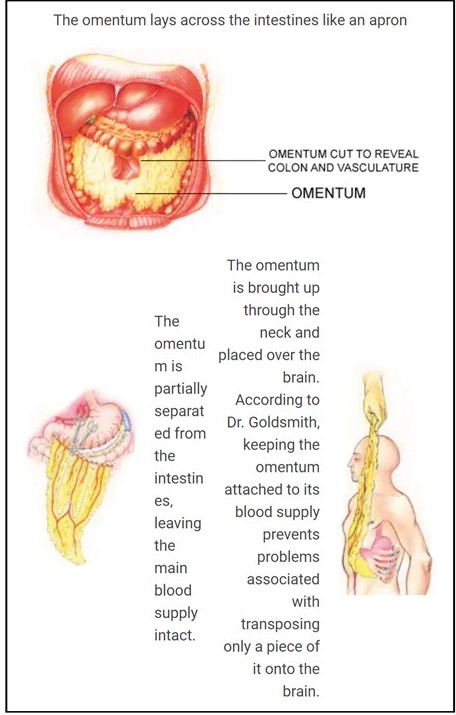About 20 years ago, five patients with Alzheimer’s improved their memory and function following surgery by Dr. Harry Goldsmith. * CBS aired a special about the people with Alzheimer’s who chose Dr. Goldsmith’s elective procedure to bring oxygen-rich omentum to their dying brain cells. In 2000, I had the pleasure of talking with Neurosurgeon Goldsmith by phone for about an hour following his CBS appearance. I was interested in this surgery for my father who lived with Alzheimer’s. The doctor declined, explaining that the risks of this procedure for a 90-year-old were too high.

What happened to Omentum Surgery?
I reached out to Dr. Goldsmith recently, twenty years after our last contact. He was delighted to learn that I was still interested. Thankfully, he is still actively publishing in his late 80s or early 90s.
Let us take a step back for context.
In the late 1990s, Alzheimer’s researchers focused on two areas, tau tangles and beta amyloid plaques. Both were viewed as contributing causes to Alzheimer’s. Over the years, research on beta amyloids. Tau research became tangled with no funding. Despite the focus on amyloid plaques, autopsies have shown brains riddled with these plaques despite people having lived fully functional lives without any Alzheimer’s symptoms.
What gives?
Consistently, findings point to Alzheimer’s caused by the lack of oxygen resulting in brain cell death.
Since biomedical research has not yet sufficiently breached the blood-brain barrier, how else can dying cells achieve oxygen?
Dr. Goldsmith had the answer more than 20 years ago.
Why have few listened?
Much can be because funding tends to be politically directed by large pharmaceutical companies who lobby political figures who then allocate funding to the National Institutes of Health (NIH). How the political machinations unwind is anyone’s guess, but after seeing what’s occurred in our field for the last quarter century, we’re not operating entirely in the best interests of loved ones trying to live independently with Alzheimer’s or other cognitive challenges due to dementia. Besides, not everything in life can be cured by a pill.
It’s Time to Reconsider Omentum Surgery for Alzheimer’s
While BIOGEN’s recently approved Aduhelm runs an estimated annual cost of $56K, bringing oxygen-rich blood to the brain at even twice this cost may be a more lasting solution after a one-time investment.
I called neurosurgeon Dr. Harry Goldsmith, who pioneered omentum surgery for Alzheimer’s patients. Twenty years ago, the patients who had no other pre-existing conditions beyond Alzheimer’s, enjoyed noticeable success.
Our conversation covered many areas with no real solutions. Why has this successful surgery received little interest from the likes of the Alzheimer’s Association and the NIH? It’s likely due to special interests and funding. Yet, a small group of enterprising researchers could generate interest once more in omentum surgery for Alzheimer’s. This could lead to other treatments that would bring us closer to a cure than anything has these last 25 years.
In his 2017 article, “Alzheimer’s disease can be treated: Why the delay?” [Click on “Read the full text.”]
During our call, he gave a simpler explanation of what happens in the brain leading to Alzheimer’s:
Alzheimer’s disease is the result of decreased blood flow to the brain or reduced cerebral blood flow (CBF). Brain cells (neurons) must maintain energy to survive. Their source of energy is adenosine triphosphate (ATP). Neuronal activity (energy) is controlled by intraneuronal mitochondria. A decrease in blood flow, CBF, impairs production of ATP; thus, lowering oxygen and glucose necessary for brain function.
Betty Weiss wrote a book about the successful results and greater function while her husband lived with Alzheimer’s, after omentum surgery. It was covered in 2000: An Exciting New Treatment for Alzheimer’s A look at Dr. Harry S. Goldsmith’s revolutionary treatment.
Prominent Iranian mathematician, Mr. Gayour showed remarkable improvement following surgery. Sadly, he suffered a fatal heart attack months later, likely unrelated to the surgery. No link was addressed in the article.
The river of life keeps flowing. Sometimes, when we turn to look back, we may find something worthy of reexamination by the water’s edge. Merging past knowledge with what we know today, will magnify what may prove to be a lasting and successful treatment.
Even if the surgery costs double that of a one-year treatment with Biogen’s newly approved drug, consider the lasting effects for a person with Alzheimer’s.
*Dr. Goldsmith graduated from the Boston University School of Medicine in 1956 and did his residency at Memorial Sloan-Kettering Cancer Center in General Surgery, from 1963 – 1965. He worked in Glenbrook, NV and held a CA State Medical License from 1985 – 2016.









For more, read, Silos Deter Collaboration: Implications for Dementia Care and Research
With millions of lives at stake, a solution is urgently needed.
https://health.usnews.com/health-care/for-better/articles/2017-02-24/silos-deter-collaboration-implications-for-dementia-care-and-research